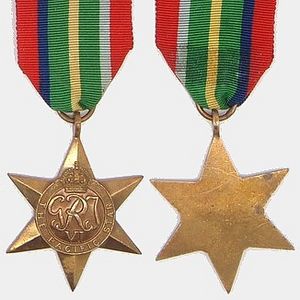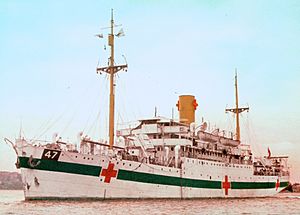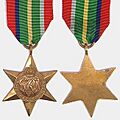Pacific Star facts for kids
Quick facts for kids The Pacific Star |
|
|---|---|
 |
|
| Country | |
| Type | Military campaign medal |
| Eligibility | All Ranks |
| Awarded for | Service in operational area |
| Campaign(s) | Pacific 1941–1945 |
| Clasps | BURMA |
| Statistics | |
| Established | May 1945 |
| Order of wear | |
| Next (higher) | Africa Star |
| Next (lower) | Burma Star |
| Related | Burma Star |
Ribbon bar without and with Burma Clasp rosette |
|
The Pacific Star is a special medal. The United Kingdom created it in May 1945. It was given to soldiers, sailors, and air force members. These brave people were from Britain and other Commonwealth countries. They served in the Pacific Ocean during World War II. This was from 1941 to 1945. A small bar called 'Burma' could be added to the medal's ribbon.
Contents
Medals of World War II
During World War II, many special medals were created. These were called "Stars." They honored people who served in different campaigns. The first two Stars were made in 1943. By 1945, there were eight Stars and nine clasps. A clasp is a small bar worn on the medal's ribbon.
Later, in 2013, two more awards were added. These were the Arctic Star and the Bomber Command Clasp. Even with these additions, no one could earn more than six campaign Stars. Only one clasp could be worn on any single Star medal.
Here are some of the main Stars awarded:
- The 1939–1945 Star was for service throughout the war.
- The Atlantic Star was for fighting in the Battle of the Atlantic.
- The Arctic Star was for dangerous Arctic convoys.
- The Africa Star was for service in North Africa.
- The Pacific Star was for service in the Pacific.
- The Burma Star was for service in Burma.
- The Italy Star was for fighting in Italy.
- The France and Germany Star was for campaigns in Europe.
Everyone who received a campaign Star also got the War Medal.
Why the Pacific Star Was Created
While fighting was happening in Europe and Africa, Allied forces also fought Japan. This part of World War II was called the Pacific Campaign. It started on December 8, 1941. This was the day after Japan attacked Pearl Harbor.
The war in the Pacific involved battles at sea, in the air, and on land. Japanese forces quickly took over places like Malaya and the Philippines. By mid-1942, the Allies stopped Japan's advance. But the fighting continued until Japan surrendered on September 2, 1945. The Pacific Star was created to honor those who served in this important campaign.
Who Earned the Pacific Star
The rules for getting the Pacific Star were different. They depended on if you served at sea, on land, or in the air.
General Rules
You could not receive both the Pacific Star and the Burma Star. If you qualified for both, you received the Pacific Star. Then, a 'Burma' clasp was added to its ribbon.
If someone received a gallantry medal or was mentioned for bravery, they got the Pacific Star. This was true no matter how long they served. Also, if someone died or was injured because of their service, they received the Star.
Service at Sea
Sailors and Merchant Navy members could earn the medal. They had to serve for at least one day in the Pacific Ocean. This included the South China Sea and parts of the Indian Ocean. This service counted after they had already earned the 1939–1945 Star.
In 1994, Australia changed the rules for the Pacific Star. Any Australian military member on the hospital ship Centaur when it sank in 1943 could get the medal. This was allowed even if they didn't meet other medal requirements.
Service on Land
Army, Navy, and Air Force members serving on land qualified. They had to be in areas where there were enemy or Allied invasions. There was no minimum time for service in these areas.
Some of the places where land service qualified included:
- Hong Kong (December 1941)
- Malaya (December 1941 to February 1942)
- Philippines Islands (December 1941 to September 1945)
- New Guinea (March 1942 to September 1945)
- Solomon Islands (February 1942 to September 1945)
Service in places like China or Sumatra after certain dates counted for the Burma Star instead. Service in places like Fiji or New Caledonia did not qualify for the Pacific Star.
Airborne Service
Air crew members qualified if they flew missions against the enemy. They needed to have already earned the 1939–1945 Star. They also had to complete at least one mission over the qualifying sea or land areas. Air crew on transport planes qualified if they landed three times in these areas. Troops who took part in airborne operations also qualified.
About the Medal
The Royal Mint designed all the World War II campaign Stars. They are six-pointed stars made of a yellow metal. They are about 44 millimeters wide.
- Front of the Medal
The front of the medal shows the letters "GRI VI." This stands for King George VI. A crown sits above these letters. Around the edge, it says "THE PACIFIC STAR."
- Back of the Medal
The back of the medal is plain.
- Naming the Medals
Most British forces' World War II medals were not named. However, medals given to soldiers from India, South Africa, and Australia were named. They had the recipient's service number, initials, and last name.
- Clasp
The clasp is a small metal bar. It is sewn onto the medal's ribbon. If the medal is not worn, a small silver flower shape is placed on the ribbon bar. This shows that the clasp was awarded.
- Ribbon
The ribbon is 32 millimeters wide. It has bands of different colors. There are red bands for the Army, dark blue for the Navy, and light blue for the Air Force. The dark green and yellow bands represent the forests and beaches of the Pacific. King George VI himself designed the ribbons for most of these Stars.
How to Wear the Medals
The World War II campaign Stars are worn in a specific order. This order is based on when each campaign started. Even if someone earned them in a different order, they are always worn this way. The Defence Medal and War Medal are worn after the Stars.
Here is the order of wear for the main Stars:
- The 1939–1945 Star
- The Atlantic Star
- The Arctic Star
- The Air Crew Europe Star
- The Africa Star
- The Pacific Star
- The Burma Star
- The Italy Star
- The France and Germany Star
- The Defence Medal
- The War Medal
![]()
![]()
![]() The Pacific Star is worn after the Africa Star. It is followed by the Italy Star or other medals lower in rank. Remember, you would not wear the Burma Star after the Pacific Star, because the Burma clasp would be on the Pacific Star's ribbon instead.
The Pacific Star is worn after the Africa Star. It is followed by the Italy Star or other medals lower in rank. Remember, you would not wear the Burma Star after the Pacific Star, because the Burma clasp would be on the Pacific Star's ribbon instead.
Images for kids



